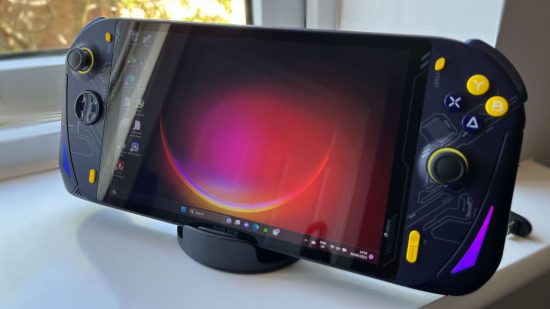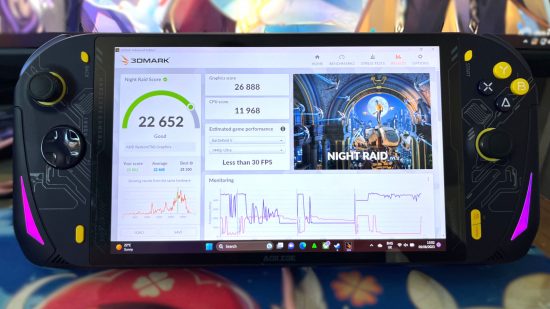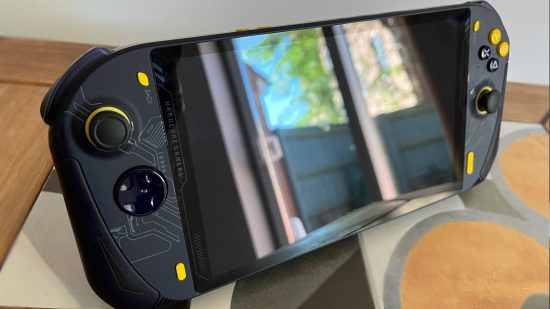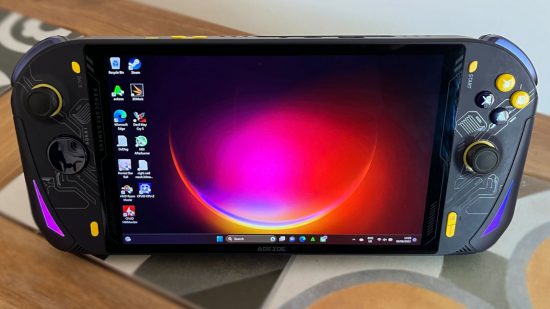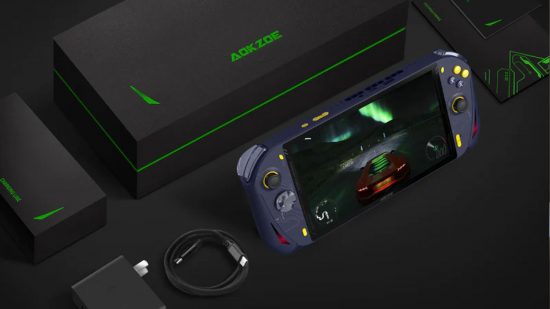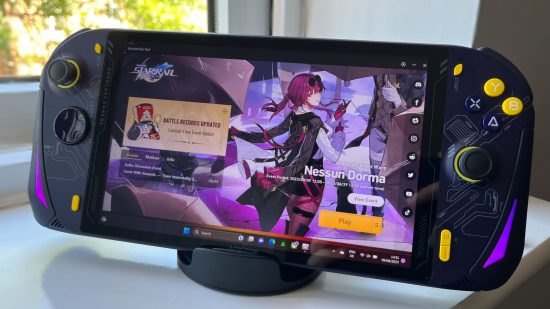Our Verdict
The Aokzoe A1 has some genuinely impressive features, from its AMD Radeon 680M graphics card to its customizable power output, and it's certainly capable of running most of your favorite games in the palm of your hands. However, with its mediocre screen, steep price, and stiff competition, it may be worth looking elsewhere for your portable paradise.
I love all forms of portable gaming, but I am, and always will be, a PC gamer at heart. This is what makes handheld, portable PC’s like the Aokzoe A1 so attractive – and I’m sure to many other gamers out there, too. But how much of it is just hype? Can such a small device really deliver on such a big promise? Let’s find out as we dive deep into the specifications, performance, display, battery life, and more in our Aokzoe A1 review.
If you get to the end of our Aokzoe A1 review and decide this isn’t the handheld for you, there are plenty of other portable powerhouses for you to peruse in our list of the best portable gaming consoles. You can also sink your teeth into our Steam Deck review, ASUS Rog Ally review, or Ayaneo 2 review. You can also take a peek at our how we test breakdown to find out more about our tech-related processes.
Now, get your thumbs at the ready, as we dive into our Aokzoe A1 review.
Pros:
- Powerful graphics card
- Ability to play your entire PC games library on the go
Cons:
- Not ergonomic in design
- Mediocre screen
- Gets very hot
- Expensive
Price and availability
The Aokzoe A1 is a powerful little machine, but its price packs just as much of a punch. Here are the MSRPs for each of the different versions:
- 16GB+512GB – $1,079
- 16GB+1TB – $1,219
- 16GB+2TB – £1,399
- 32GB+1TB – $1,529
- 32GB+2TB – $1,529
Since Aokzoe released the new Pro handheld, the different versions of the Aokzoe A1 have been on sale for 20-25% off, slashing the top version down to $1,259 and the cheaper version down to $859. This puts it in a much more affordable bracket, and you can sometimes snag a refurbished unit even cheaper.
However, with its main competitor, the Asus ROG Ally starting at as little as $599, and the less-powerful but less-fiddly Steam Deck going for even less, it’s got some pretty stiff competition when it comes to price and affordability.
In terms of availability, you can purchase the Aokzoe A1 from the company’s official website or Amazon. Aokzoe ships worldwide, either through expedited shipping (FEDEX, DHL, USPS, etc) in about 7-10 business days or standard shipping (airmail, priority mail, etc) in about 15-25 business days.
From our experience, the product ships from a warehouse in China, so you may be liable to pay customs on arrival, though reviews seem to be mixed on this. There are also mixed reviews on customer support if something goes wrong with your console, with some people attesting to the fact that they had their units fixed or replacements sent out quickly, while others say they received little communication and support.
Specifications
- CPU: AMD Ryzen 7 6800U, Zen 3+ framework / 8 cores, 16 threads / 4.7 Ghz single core max frequency
- Graphics: AMD Radeon 680M / RDNA 2 graphics framework 12 graphics cores / 2200 MHz graphics frequency
RAM: 16GB / 32GB - Storage: 512GB / 1TB / 2TB, plus room for SD card
- Screen: 8-inch fullfit IPS screen / resolution 1920 x 1200 / pixel density 283PPI / brightness 350Nit / supports ten-point touch
- Battery: 65Wh, 17100mAh (3.85V) / 100W GaN PD charger
- Ports: two USB-C 4.0 / one USB-A 3.0 / 3.5mm audio jack / TF card slot

Design
The Aokzoe A1 is a pretty slick device and looks quite the part. With programmable RGB light strips on the front, a deep blue shell with light gray geometric patterns, bright yellow joysticks, and yellow and navy buttons, it fits well into the typical gamer aesthetic – though this may be a turn-off for those who prefer the more muted design of handhelds like the Steam Deck. There’s also some fine, cheesy text next to the screen that says ‘Aoka1’ and ‘hardcore gamers’. This may also be unappealing for some people, but personally, I find it quite endearing.
In terms of size, it comes in at 11” long, 5” wide, and about 1.5” deep including the grips, making it about the same size as the Steam Deck in length and depth, but a little shorter in width. It does weigh quite a bit more than the Steam Deck, though.
According to my trusty little kitchen scales, the Steam Deck is 23.7oz / 674g, whereas the Aokzoe A1 weighs in at 25.9oz / 735g. While the difference of 2.2oz / 61g doesn’t sound like much, weightofstuff.com suggests that it equates to around the weight of a small kiwi fruit, a C-size battery, or 60 US bills, and it definitely does make a difference when it’s in the palm of your hand for a long period of time.
There’s an intake fan on the back of the console, while the output fans are on the top, allowing for pretty comfortable airflow while still allowing you to rest the bottom of the console while playing. On top of that it has two USB outputs for you to connect any peripherals you please – be it a wired headset, controller, or even an internet dongle if you like.
I also very much appreciate the USB-C input on both the bottom and the top, allowing for more flexibility so you can charge while playing. There’s also a small metal kickstand at the back. While the console is quite heavy and the stand feels somewhat flimsy at first, I’ve had no issues with it toppling over, and it is a nice feature – especially if you don’t have a dock or case to keep it in.
Speaking of docks, while there doesn’t appear to be an official Aokzoe one, those aforementioned dual USB-C inputs make the Aokzoe A1 flexible in terms of third-party docks.
I’ve got a nice little 6-in-1 dock from Syntech (you can read more about this piece of kit in our Syntech docking station review) which adds three extra USB 3.0 ports, an HDMI output, and an ethernet port for a stable internet connection. As the Aokzoe A1’s charger cable is USB-C to USB-C, you can plug it into the back of this dock, hook up your console through the USB-C input on the top, connect a controller through Bluetooth or USB, and then you’re free to play your PC games on your TV while also charging the device.
The ‘e-sport inching bumpers’ and full-function analog triggers on the top of the console feel comfortable in both positioning and tactility, and their pressure sensitivity is on point, making them a great choice for car games that use the triggers to accelerate. I also have no issues with the main buttons on the right of the console, either – they have a nice, tactile feel when you press them, and they read inputs well. The console also has dual vibration motors if you like that rumble.
The gaming joysticks are small but comfortable. Their shape and texture is reminiscent of the Nintendo Switch’s joysticks, and they’re very responsive, showing no blind spots at all. The smaller yellow buttons for the off switch, volume controls, etc are quite stiff, but read inputs fine. I also really appreciate the addition of the turbo button, as well as the neighboring button that manually invokes the on-screen keyboard – a much-needed boon, especially when setting up Windows initially.
On the other hand, the eight-directional D-pad is less than satisfactory. It feels and looks cheap – in fact, it’s reminiscent of those low-quality, third-party PlayStation 2 controllers from the early 2000s – and its inputs are very poor. It’s unreliable and often reads two inputs instead of one, so precise, directional controls required for retro fighting games or anything of the like are a no-go on this console.
The other issue is the lack of ergonomics. While the plastic shell itself is inoffensive, it does feel quite cheap and begins to creak after a while. Additionally, though raised grip on the back of the handle adds some much-needed comfort (which was missing for the previous Aokzoe handheld), its heavy weight, smooth surface, and lack of tactile grip make it quite uncomfortable over long periods.
I often find it slipping as I play, and, especially with my smaller hands, its top-heavy design leads to tension and pain in my outer wrists and forearms after long play sessions. I feel like a couple of ridges, silicone pads, or even a rougher surface where you place your fingers and palms would help a lot.
Performance
The Aokzoe A1 is an interesting device in terms of performance. Naturally, its graphics card is the shining star here, and it certainly stands up well against its competition in terms of raw power.
Firstly, the main thing to note is the built-in turbo button. Rather than toggling anything, the turbo button invokes the Aokzoe app overlay, which allows you to fiddle around with a few different settings. Track fan speeds, change brightness, switch up the RGB color profile, all that fun stuff – but let’s face it, the main feature here is the power output.
On the lowest wattage setting, the Aokzoe’s battery lasts much longer, but it doesn’t compete well with other handhelds. However, whack that baby up to 16W and it’s on par with the Steam Deck, and at 28W it blows the Steam Deck and many of its competitors out of the water. This does, of course, heat things up substantially and drain the battery much quicker, but the payoff is genuinely impressive.
I’ve put it through quite a few benchmarking tests, with my favorite being 3DMark (you can purchase this on Steam, I picked it up while it was on sale for around $10). I tried a few different tests to put the Aokzoe A1 through its paces, and the results are quite respectable for this small yet powerful beast.
In 3DMark’s Night Raid test for PCs with integrated graphics cards, the Aokzoe A1 got a ‘good’ score of 22,652, broken down into a graphics score of 26,888 and a CPU score of 11,968. In the first graphics test, it achieved an average of 106.49 FPS, and in the second it hovered at an impressive 163.79 FPS, with the CPU test coming in at 48.0ms. If this is all Latin to you, it basically means that the Aokzoe A1 has the potential to run games pretty well.
3DMark also suggests that it could manage the following games and framerates at 1080p ultra:
- Battlefield V – 50+FPS
- Apex Legends – 55+ FPS
- GTA V – 145FPS
- Red Dead Redemption 2 – 30+ FPS
- Fortnite – 175+ FPS
When comparing results online, 3DMark’s Night Raid test suggests that the Aokzoe A1 sits just below the average 2020 gaming laptop, and quite a jump ahead of a 2020 office laptop. That’s pretty respectable for such a small piece of kit!
Of course, beyond benchmarking, I’ve been putting it through some practical tests, too, and endeavored to do so through a range of different games, both new and a couple of years old to see how it stands up. The Xbox app was already installed when I set up Windows (er, thanks Microsoft, I guess) so I logged into my account to access my PC Games Pass and immediately installed a few different games including Amnesia: The Bunker, Disney Dreamlight Valley, and Power Wash Simulator.
Then I headed over to Steam and naturally got my beloved Resident Evil 4 Remake installed, along with Resident Evil 7, Devil May Cry 5, and Spirit Hunter NG. Then, of course, as a long-term Hoyo fanatic, I got Genshin Impact and Honkai Star Rail set up with their individual launchers.
I’m pleasantly surprised by just how well the Aokzoe A1 handles such a wide breadth of games despite its small size. Generally, it goes with medium to high settings (with the occasional low) automatically, and manages smooth performance with mostly stable framerates and very minimal stuttering.
Load times are generally snappy (though this sometimes relies on the stability of your WiFi), and inputs are responsive. Its lower resolution and refresh rate (which we’ll talk about later in the display section) can make things look a little funky, especially if you’re used to a 1440P, 144Hz monitor, but overall it offers a reliable, smooth experience.
The game that impresses me the most is actually Resident Evil 4 Remake, likely due in no small part to the Fidelity FX Super Resolution 2 setting common to the recent Resident Evil games, which is designed to deliver ‘similar or better than native image quality’ and boost framerates.
Beyond that, the automatic settings definitely don’t use up the entirety of the Aokzoe A1’s potential, but considering how hot it gets after a bit of playtime, I don’t fancy pushing the poor thing any further. Overall, it runs brilliantly with only minor occasional stuttering or framerate drops in very busy areas (I’m looking at you, first village fight), and I’m relieved that I can finally yeet harpoons into Del Lago’s mouth from the comfort of my bed.
One thing that lets the Aokzoe A1 down is its temperature control. The device gets very hot, very fast, even when playing less-intense games. You can literally feel where the CPU is under your fingers due to its heat, and as it gets toastier, the performance drops.
For example, I’ve been playing Honkai Star Rail on my Aokzoe, and it doesn’t take long for it to get very toasty, even on low to medium settings. Then I whip out Honkai Star Rail’s Luocha in a battle, he puts down his healing field, and suddenly my frames are dropping left and right. I know it’s the PC version of the game, but this is quite disappointing when HSR runs better on both my iPhone and Android phone.
Unfortunately, this means that the ‘smart cooling’, ‘PC level big fan’ (quoted from the official store page) isn’t really doing that well in terms of ‘intelligent temperature control’. Even with nothing touching the console other than my small hands and only one game running, it’s not long before it starts to sound like a jet engine that you can hear from another room. To be honest, as weighty as the Aokzoe A1 already is, I wouldn’t mind some extra bulk if it meant more effective cooling so I could enjoy my games for longer without worrying about starting a fire in my house.
I do have one more gripe with the Aokzoe A1 that I must warn you about – please keep in mind that the Aokzoe overlay can trigger anti-cheat software built into certain games. While I’ve not had any issues myself due to the games that I generally play, there have been first-hand accounts of Activision banning people playing Modern Warfare 2 on the Aokzoe A1 as the game’s anti-cheat measures flagged the overlay as unauthorized software or an unsupported application.
Therefore I recommend that you remain very careful when playing any games that have anti-cheat measures. If you do decide to take the plunge, make sure you sort all your settings and completely close the Aokzoe app before launching the game, and don’t press that turbo button until you’ve exited back to the desktop.
Storage
As mentioned above, there are a few different versions of the Aokzoe A1 available – 16GB RAM with 512GB, 1TB, or 2TB storage, or 32GB RAM with 1TB or 2TB storage. I have the 16GB + 512GB version, which still has plenty of space for my favorite games.
Bizarrely, the SSD is partitioned, with 163GB available on the C drive and 300GB available on the D drive. Partitioning does have a practical use in some laptops, allowing your computer to treat portions of your drive as separate entities. But as far as I know, it isn’t really needed here due to the Aokzoe A1 being predominantly aimed at gaming, whereas laptops and desktop PCs are more catch-alls intended for other uses.
It’s also pretty easy to forget about the partition and think you’re running out of space, when in reality you have the entirety of the 300GB D drive available (or maybe that’s just me being a ditz). Luckily, even if you forget about the D drive or you manage to fill up all that space, the Aokzoe A1 also has a 3.0 micro SD slot, allowing for some extra storage.
OS
The Aokzoe A1 runs on a full PC version of Windows. This means it’s a little more fiddly than handhelds like the Nintendo Switch or the Steam Deck, which come with their own operating systems pre-installed, but it also gives you more flexibility. It takes a bit of time to set up initially and comes with the usual Windows bloat. However, with help from the handy keyboard button and a bit of patience, it pays off in the end, and the overall out-of-the-box experience isn’t too bad at all.
After that, you’re free to install any launchers you like. As indicated in the performance section, that includes Steam, Epic Games Store, and Xbox (yes, you can access Xbox PC Games Pass through this). You can also download individual launchers for games like Genshin Impact, Honkai Star Rail, Final Fantasy XIV, Overwatch, and World of Warcraft, as well as any browser you like.
Due to its Windows PC install, it can do just about anything a laptop or desktop computer can, including browsing the web, watching videos on YouTube, streaming movies and TV on Netflix, or even noting down ideas for that novel you’ve always been meaning to write in Word or Notepad – though you may want to invest in a mobile keyboard if you fancy the latter, as the Windows native on-screen keyboard is a bit clunky, and you can’t re-program the button to switch to the alternate accessibility keyboard.
The Aokzoe also has Bluetooth support, and you can connect to and manage your Bluetooth devices (controllers, headphones, etc) through the usual Windows Bluetooth & Devices menu. Its connectivity is reliable, and I often use my wireless earbuds while playing.
Display and sound
The Aokzoe A1 features an 8-inch, fullfit IPS display, with a pixel density of 283PPI, a resolution of 1920 x 1200, DC dimming, and a brightness of 250nit. Overall, it looks pretty good and displays colors well, but I feel an OLED display would make a big difference in making games look more vivid and rich.
Its PPI (number of pixels per inch) could be higher, with most modern phones sitting at around 350 or more. Its brightness is also a little underwhelming at 250nit, especially considering good brightness on a phone is considered around 800 to 1200nit.
As a result, the Aokzoe’s display really doesn’t hold up well in natural light, even if you go into the Aokzoe overlay and whack it up to max – this is especially noticeable when playing darker games like Amnesia: The Bunker or Resident Evil 4 Remake – so no mowing down those ganados out in the garden, sadly.
Naturally, the lower resolution does take some of the sparkle out of certain games, but that’s entirely to be expected considering the size of the screen, and is far less noticeable in games that offer that shiny AI upscaling I mentioned earlier.
The screen also supports ten points touch, which is a nice addition for desktop mode and some games like Genshin Impact or Honkai Star Rail. Sadly, many titles don’t support touchscreen controls though – for example, in Power Wash Simulator a tap registers as a mouse click and starts spraying wherever your joystick is pointed, so you can’t easily tap to open a menu or change your nozzles. Of course, this isn’t a fault on Aokzoe’s end, just an observation for those hoping to spray surfaces with the swipe of a finger.
It’s a mission to find the screen’s refresh rate anywhere online, but by looking at Windows display settings I discovered that it’s set at 60Hz. This is decent and the same as the Steam Deck’s, but once again pales in comparison to high-end gaming phones, and is half the refresh rate of the ROG Ally’s 120Hz.
If you’re a bit lost about how this makes a difference, the refresh rate of your display refers to how many times per second your display is able to draw a new image, which affects how smooth things look. Generally, for gaming, you want your screen to be 120Hz or higher.
One interesting feature of the display is tied to the console’s 6-axis sensor, which allows you to hold your Aokzoe A1 vertically and have the screen rotate with you. I’m not really sure where this will be useful, as, even if you do have a game that runs better in portrait mode, it’s quite unwieldy at this angle. Luckily, you can head to the Windows display settings and toggle the rotation off if you like. There may be other uses for this 6-axis sensor beyond rotating your display, but I’ve yet to find a PC game that supports the feature.
Now, onto the sound. The Aokzoe A1 has two speakers in what the Aokzoe website refers to as a ‘double stereo base cavity’ located at the bottom of the console, on either side of the screen – they sit pretty close to where your palms and thumbs lay naturally when holding the device.
You can control the volume through two raised buttons on the top, with the left button turning it up and the right button turning it down. This feels like it’s backwards, considering other consoles like the Steam Deck and the Nintendo Switch have the volume buttons the other way around, but that’s neither here nor there.
The volume pumps up pretty high but, as you’d expect from a small, built-in speaker, the quality isn’t all that great. It sounds quite tinny and lacks bass, but it does the job fine – though I do generally prefer to connect to my noise-canceling wireless earbuds for a more immersive sound experience.
Battery life
The Aokzoe features a 65Wh pro version battery with a capacity of 17100mAh. In comparison, the Asus Rog Ally and the Steam Deck both sit at 40Wh. This means that, at full charge, the Aokzoe has quite a bit of juice, even when compared to its main competitors. But how does this tie into playtime?
Well, naturally it depends on how you’re using your Aokzoe, and what settings you’ve got it running at. While playing Power Wash Simulator on the Xbox Games Pass at the max 28W (no background apps beyond the usual Windows bloat) on high settings, a full battery lasted me around an hour and a half, and it was around that same ballpark for Resident Evil 4 Remake, Devil May Cry 5, Disney Dreamlight Valley, and most of the other games I played.
Of course, if you wack that performance down and play some less intense games like Roblox or simply browse the web, then the battery will last you longer. But honestly, for my personal preference in games, I generally stick to the 28W option, so I need to plug that bad boy in every 60 to 90 minutes to top up that juice.
Luckily, as mentioned in the design section, it does have a USB-C input in both the top and bottom of the console, allowing you to choose the position that suits you most while playing. It also charges via cable at a respectable 100W, though with its large battery capacity, it still takes a while. In sleep mode with no programs running in the background, it takes around an hour and a half to fully charge – of course, it also takes a bit longer to charge if you’re still playing while plugged in.
Oh, I should also talk about the charger, right? Well, the Aokzoe comes with its own charger cable, plug, and adapter. The charger cable itself is USB-C to USB-C, and you insert it into the type-A plug brick, which you can then plug into the type-G adapter if needed.
The plug is quite large (2 inches deep, 2.5 inches tall, 1.3 inches wide) and weighty (6.14oz / 174g), which means it hangs quite heavily on the small type-G adaptor. The main type-A plug brick’s build quality is nice and sturdy, though it does get very hot when you leave your console charging for a while.
Verdict
Okay, so after spending so much time with the Aokzoe A1, what’s the outcome? Would I recommend it as a solid portable gaming console? Well, yes and no.
Overall, it’s an impressively powerful little device that can handle a wide range of games, and offers a lot more flexibility that competitors like the Steam Deck and the Switch due to its PC Windows OS that allows you to download any launchers you want rather than being tied to Steam or the Nintendo eShop. It can also run most games pretty darn well, especially with the easy-to-access Aokzoe overlay that allows you to change the power output.
However, it does struggle to stand up against its more direct competition, especially considering its steep price – even on sale. The ASUS Rog Ally does fall behind in some areas, but beats the Aokzoe A1 in others, all for a much cheaper price. Even Aokzoe itself has now brought out the A1’s predecessor, the Aokzoe A1 Pro, which is very close to the A1’s MRSP and seems to iron out a lot of the kinks.
With its impressive graphics card, customizable settings, and ability to run some taxing games pretty well, it does make for a strong portable console. However, with its mediocre screen, uncomfortable grips, short battery life, and tendency to run hot, I struggle to say it’s worth full price.
If you can find it at a heavy discount, it’s definitely worth a try – especially if you’re interested in tech and hardware and want to play around with it firsthand. But if you’re looking for a comfortable handheld that gives you plenty of bang for your buck, perhaps look to its competitors or successor.
Right, I’m off to play some more Resident Evil 4 Remake on every console that runs it. If you do fancy some more tech talk or are looking for a fresh phone to wow you, check out our guides to the best Xiaomi phones, the best 4G phones, the best Google Pixel phones, or the best budget gaming phones. Alternatively, you can snap up some in-game freebies with our Coin Master free spins, Honkai Star Rail codes, and Genshin Impact codes. See ya around, ‘hardcore gamers’.
